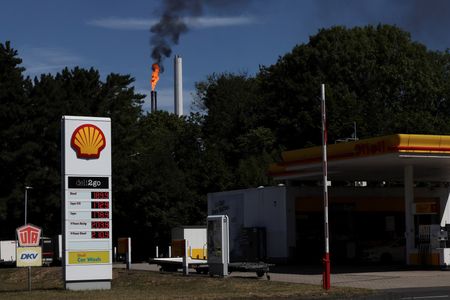By Ron Bousso
LONDON (Reuters) -Shell reported first-quarter profit of $7.7 billion on Thursday, exceeding expectations as disruption to Red Sea shipping and Russian refining boosted oil trading and liquefied natural gas (LNG) production rose.
The company said it will buy back a further $3.5 billion of its shares over the next three months, at a similar rate to the previous quarter. Its dividend remained unchanged.
Shell’s cashflow rose by 6% from the previous quarter to $13.3 billion, reflecting strong operational performance, particularly in the LNG division, which together with trading helped offset a decline in natural gas prices that weighed on earnings of rivals including Exxon Mobil and Chevron last week.
“Shell delivered another quarter of strong operational and financial performance, demonstrating our continued focus on delivering more value with less emissions,” CEO Wael Sawan said.
Analysts had expected first-quarter adjusted earnings of $6.46 billion, against $9.65 billion a year earlier. The company had posted $7.3 billion in the fourth quarter of 2023, boosted by strong LNG trading results.
Shell’s shares closed up 1.9%, compared with a 0.7% decline in the broader European energy index.
Shell’s chemicals and products divisions, which include refining and oil trading, registered a more than threefold rise in adjusted earnings from the previous quarter to $2.8 billion.
Refined oil product trading was boosted by disruptions to shipping in the Red Sea as well as outages at Russian refineries because of Ukrainian drone attacks in recent months, finance chief Sinead Gorman told reporters.
Shell also timed refinery maintenance for the last quarter of 2023 while most of its peers opted for the first quarter of the year, giving Shell a further advantage in supplying oil products such as gasoline and diesel, Gorman said.
“Shell has beaten expectations by a reasonable margin, despite the impact of lower gas prices during the first quarter. Earnings are up, costs have fallen, and the oil and gas major has brought debt down too – all in all, it’s a solid set of numbers,” said Stuart Lamont, investment manager at RBC Brewin Dolphin.
Sawan later told analysts that although Shell’s shares were trading below “fair market value at the moment,” the London-listed company was not actively looking at switching its listing to New York as some companies have done.
STRONG LNG
Shell’s shares have gained about 14% this year, buoyed by Sawan’s efforts to cut costs and focus the company on its most profitable operations. On Wednesday Reuters reported that Shell had exited China’s power market.
In March, Shell weakened a 2030 carbon reduction target and scrapped a 2035 objective, citing expectations for strong gas demand and uncertainty in the energy transition even as it affirmed a plan to cut emissions to net zero by 2050.
Shareholders will vote later this month on Shell’s strategy as well as a shareholder resolution calling on the company to tighten climate targets.
Earnings at Shell’s flagship LNG trading business were 7% below the previous quarter, when it had bumper trading results, but they still beat expectations.
Shell’s LNG production rose in the quarter by 7% from the previous three months to 7.58 million metric tons while sales dropped by 7% to 16.87 million tons. The growth was driven by higher output from the giant Prelude floating LNG facility off the western coast of Australia.
While Shell is the world’s top LNG trader, it is not present in the U.S. shale patch, where a huge excess in natural gas has weighed heavily on prices, denting profits of producers such as Exxon and Chevron in recent months.
Shell’s overall oil and gas production rose by 3% in the quarter to 2.91 million barrels of oil equivalent per day.
(Reporting by Ron BoussoEditing by David Goodman, Jane Merriman, Elaine Hardcastle, Susan Fenton and Leslie Adler)











